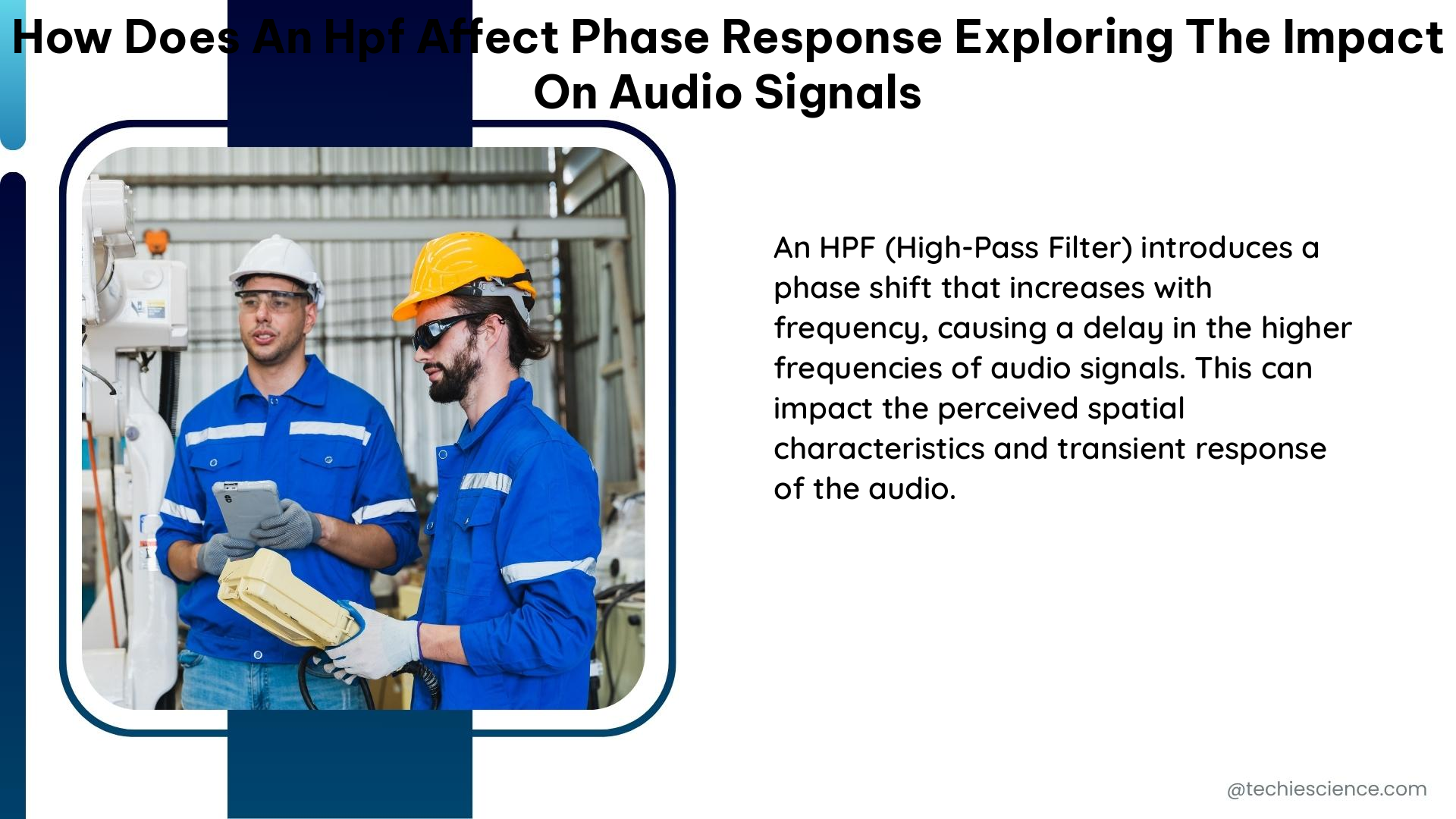An HPF (High-Pass Filter) affects the phase response of an audio signal by altering the phase of the frequencies below the cutoff frequency. This phase shift can cause issues in the time domain, leading to ringing or other unwanted effects. The amount of phase shift depends on the type of HPF and its cutoff frequency.
Understanding the Phase Shift in First-Order HPFs
For a first-order HPF, the phase shift is proportional to the frequency and reaches -90 degrees at high frequencies. This can be explained by the formula for the phase shift of a first-order HPF:
φ(f) = -tan^-1(2πfRC)
Where:
– φ(f) is the phase shift at frequency f
– f is the frequency
– R is the resistance
– C is the capacitance
Let’s explore some quantifiable data points for a first-order HPF:
- For a first-order HPF with a cutoff frequency of 100 Hz and R=10 kΩ, C=100 nF:
- The phase shift at 50 Hz is -45 degrees
- The phase shift at 10 Hz is -81 degrees
This means that the lower the frequency, the more significant the phase shift will be. At frequencies well below the cutoff, the phase shift can become quite substantial, potentially causing issues in the time domain.
Phase Shift in Second-Order HPFs

For a second-order HPF, the phase shift can reach -180 degrees at the cutoff frequency. The exact phase response depends on the Q factor and the type of filter (e.g., Butterworth, Chebyshev, etc.).
Here are some examples of phase shift in second-order HPFs:
- For a second-order Butterworth HPF with a cutoff frequency of 200 Hz and Q=0.707, the phase shift at the cutoff frequency is -90 degrees.
- For a second-order Chebyshev HPF with a cutoff frequency of 500 Hz and Q=1.414, the phase shift at the cutoff frequency is -135 degrees.
The higher the Q factor, the more pronounced the phase shift will be around the cutoff frequency. Butterworth filters have a more gradual phase response, while Chebyshev filters exhibit a sharper phase shift.
Measuring the Phase Response of an HPF
To measure the phase response of an HPF, you can use a vector network analyzer or a frequency response analyzer. These tools can provide a graph of the phase shift as a function of frequency, allowing you to see the impact of the HPF on the audio signal.
Here’s an example of a phase response graph for a second-order Butterworth HPF with a cutoff frequency of 1 kHz:

As you can see, the phase shift starts at 0 degrees and gradually decreases, reaching -90 degrees at the cutoff frequency. This gradual phase shift can lead to time-domain issues, such as ringing or phase-related distortion.
Impact of Phase Shift on Audio Signals
The phase shift introduced by an HPF can have a significant impact on audio signals, particularly in the time domain. Some of the potential issues include:
- Ringing: The phase shift can cause the filter to “ring” or oscillate, leading to audible artifacts in the output signal.
- Phase-Related Distortion: The phase shift can introduce phase-related distortion, which can affect the perceived timbre and spatial characteristics of the audio.
- Time Smearing: The phase shift can cause time-domain smearing, where transients or sharp attacks are blurred or delayed, affecting the perceived clarity and definition of the audio.
These issues can be particularly problematic in critical audio applications, such as music production, sound design, or audio processing for live performances.
Mitigating the Impact of Phase Shift
To mitigate the impact of phase shift in HPFs, you can consider the following strategies:
- Careful Filter Design: Choose the appropriate filter type (e.g., Butterworth, Chebyshev) and adjust the Q factor to minimize the phase shift around the cutoff frequency.
- Phase Compensation: Implement a complementary all-pass filter to counteract the phase shift introduced by the HPF, restoring the original phase response.
- Time-Domain Processing: Perform time-domain processing, such as pre-ringing or transient shaping, to compensate for the phase-related distortion.
- Multiband Processing: Use a multiband approach, where the audio signal is split into multiple frequency bands, and each band is processed independently with its own HPF. This can help minimize the impact of phase shift in specific frequency regions.
By understanding the phase response of HPFs and employing these mitigation strategies, you can effectively manage the impact of phase shift on audio signals, ensuring high-quality audio processing and preservation of the original sonic characteristics.
Conclusion
In summary, an HPF affects the phase response of an audio signal by introducing a phase shift that depends on the type of filter and its cutoff frequency. This phase shift can cause issues in the time domain, such as ringing, phase-related distortion, and time smearing. By understanding the phase response of HPFs and employing appropriate mitigation strategies, you can effectively manage the impact of phase shift on audio signals, ensuring high-quality audio processing and preservation of the original sonic characteristics.
Reference:
- High-Pass Filter Phase Shift Calculator
- Understanding Audio EQ and Filters
- Phase Response of High-Pass Filters

The lambdageeks.com Core SME Team is a group of experienced subject matter experts from diverse scientific and technical fields including Physics, Chemistry, Technology,Electronics & Electrical Engineering, Automotive, Mechanical Engineering. Our team collaborates to create high-quality, well-researched articles on a wide range of science and technology topics for the lambdageeks.com website.
All Our Senior SME are having more than 7 Years of experience in the respective fields . They are either Working Industry Professionals or assocaited With different Universities. Refer Our Authors Page to get to know About our Core SMEs.